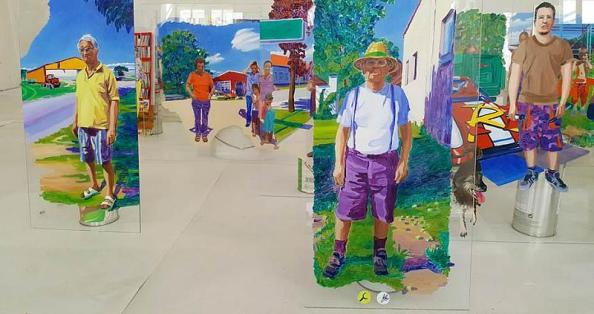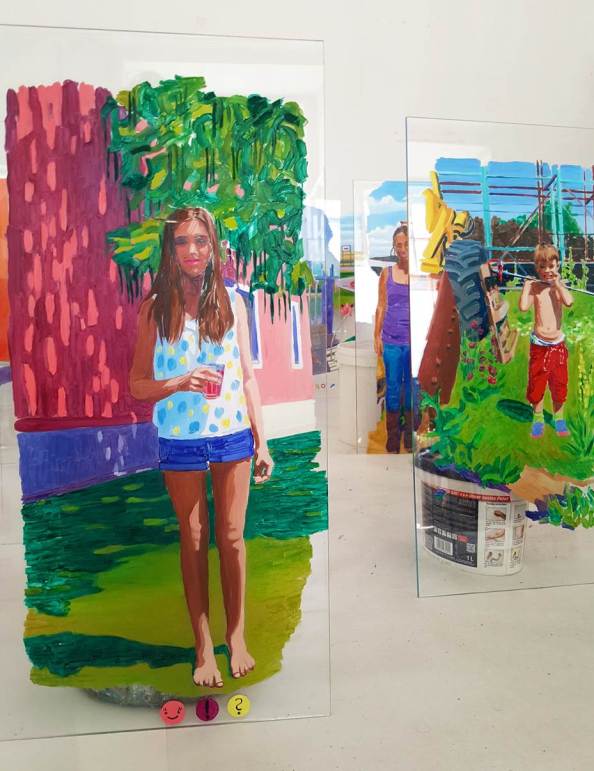
Farbstift und Firnis auf Papier, 213,4 x 225,4 cm
Helen und Charles Schwab

Farbstift und Firnis auf Papier, 213,4 x 225,4 cm
Helen und Charles Schwab



The exhibition offers a rare opportunity to explore the relationship between language used to describe the psychotic state and mystical experience, exploring the spirituality of mental illness through an immersion in sacred space. Otto Wagner’s Jugendstil Church is one of very few sacred spaces built exclusively for the mentally ill, providing a sanctuary for the patients of the Steinhof Psychiatric Hospital. The exhibition will follow KUNSTGLAUBE’s tradition of offering a pilgrimage through the Church, beginning with an invitation to contemplate both historical and contemporary understandings of madness. Each of the works will be positioned throughout the liturgical space in order to enter into a meaningful dialogue with both theology and liturgy. The journey from crypt to the church will guide the visitor through a series of video installations in the dark and damp to emerge into a light filled church completely transformed by an immersive installation.

There have only been a small number of artworks and buildings created for the specific purpose of consoling the disturbed. The Isenheim altarpiece in Colmar, France was painted specifically for patients suffering from “Saint Anthony’s fire,” a condition known as ergotoxicosis. In the paintings, Matthias Grunewald included figures affected by the same symptoms of the disease as those who prayed before it. The bloated stomachs, gangrene limbs and bodies contorted in pain appear around the crucified body of Christ who seems to bear the same wounds as those afflicted. There is evidence in the design of the Kirche am Steinhof, that Otto Wagner also endeavored to provide a space that accounted for the specific condition in which the majority of patients found themselves. At the time of the Church’s construction, over ninety percent of patients intended for internment suffered from various strains of syphilis. Aware of the highly contagious nature of the disease, holy water was distributed by tap rather than from a bowl into which many contaminated hands would have otherwise deposited and further spread the virus. The easily washable tiles on the walls and floor, emergency exits on both sides of the church, wide aisles, narrow pews and the inaccessible sanctuary are all features that have accounted for the patients. The inclusion of a depiction of Saint Dymphna, the patron saint of the mentally ill in the apse and the absence of a prominent crucifix have also sought to console the patients.
Despite having different focus areas in their respective works on mysticism, roughly six characteristics of the mystical experience can be derived from Mircea Eliade, Rudolf Otto, William James, Walter Stace and D.T. Suzuki. These characteristics include:
1) a sense of being connected/united with a supreme/transcendental other
2) a sense of being connected/united with other people/nature
3) a loss of sense of time
4) a loss of sense of space
5) an inability to articulate the experience
6) a lasting sense of peace
Attempts at categorising the mystical experience have often adopted similar language and processes to those found in the field of psychiatry. In 2006, a committee formed by prominent clinicians and researchers of the American Psychiatric Association presented an analysis of the implications of religion and spirituality for the diagnosis, course, and outcomes of psychiatric treatment. Their Research Agenda for the 5th edition of the Diagnostic and Statistical Manual of Mental Disorders (DSM-V) addressed the spiritual and philosophical issues involved in distinguishing a psychiatric disorder from a spiritual condition. Even after considerable changes to both the DSM-V and the 10th edition of the Classification of Mental and Behavioural Disorders (ICD-10), it surely remains challenging for the clinician to distinguish between religious delusions as a potential expression of a psychiatric disorder, mystical experience, and positive religious coping strategies. Disturbances that have a religious dimension should not by default be viewed as pathological. When an individual is however unable to find an acceptable explanation or social comparison for their arousal or disturbance, their inability to deal with it could eventually lead to symptoms of psychopathology.



Contemporary Art is a microparticle, which no one can find,
but every sundry can predict:
I woke up, brewed coffee; poured bamboo named Kotja and turned on the computer.
And I realised, or to say better felt, “Line”, “Color” and “light.”
Now I am in this line (A), the colour (R), illuminated by this Light (T).
And all this were Other.
Yesterday, at the same astronomical time, I did the same thing, but
A, R and T were different.
I do not know what will happen tomorrow, but it was the same day before yesterday.
It is unlikely that I will be able to explain what happened. But I can paint it
down on paper, canvas or cardboard:
And this line A, this colour R, illuminated this light, T.
This feeling I have called the “NowI”.
Artist: kostя goldtv
























Galerie CSELLEY MÜHLE Oslip, Burgenland
MARIO DALPRA “Retorno”
Malerei und Skulptur
Kunstbrunch & Vernissage:
Sonntag, 9. Oktober 2016 |11 Uhr
Eröffnung und einführende Worte CARL AIGNER
Ausstellung: 10.10 bis 01.11.2016
7064 Oslip, Sachsenweg 63
http://www.cselley-muehle.at/

http://www.cselley-muehle.at/event.php?uid=51901684
Wir nähern uns dem Künstler über seine Arbeit.
Ganz wie diese ist er verschiedenen Kulturen verpflichtet.
Dass er in so grundverschiedenen Ländern wie Österreich
und Indien lebt und arbeitet, befremdet uns nicht, wenn wir
seine Arbeiten betrachten. Auch dass er nicht nur skulptural arbeitet, sondern sich auch als Maler, Zeichner, Musiker, Film- und Performancekünstler einen Namen gemacht hat, überrascht uns nicht wirklich. Seine vielseitigen Begabungen ermöglichen es ihm, Weltkunst im besten Sinne zu schaffen, die überall auf der Welt zu Hause ist. Im Zeitalter der Globalisierung besetzen seine Arbeiten ein Terrain, das vor kurzem erst erschließbar geworden ist. Seine Malerei ist kaum greifbarer als die Skulptur, und das ist durchaus als Kompliment zu verstehen.

Mario Dalpra inszeniert mit Lust Situationen, die den Kunstfreund an seine Grenzen führen. Darf der das? Antwort: Ja, der darf das. Kanonische Festlegungen sind dem Künstler zuwider, daher kommen ihm Arbeiten gerade recht, die nicht in einen wie auch immer gearteten Kontext passen. Die bewusste Kontextvermeidung ist eine seiner künstlerischen Strategien, seine Kunst ist ein Laboratorium, in dem fast alles denkbar ist
Beinahe wie in einem Bilderbogen (nur chaotischer, oder besser: simultan) durchdringen sich da menschliche Figuren, Fauna, Flora und Texte, die in einem gewaltigen All-Over Geschichten erzählen, die sich der Betrachter selbst ausdenken muss. Auch in der Malerei finden wir die Fülle des Lebens vor, Reales, Phantastisches, Undenkbares und Traumhaftes. Wie im Traum überlagern sich die Erzählstränge und der Betrachter sieht sich unversehens vor die Aufgabe gestellt, diese Ariadnefäden zu entwirren. Dabei stößt man naturgemäß wie im Labyrinth auf tote Enden, endlose Verzweigungen, und ob es einen Ausgang gibt, ist mehr als ungewiss. Erstaunlicherweise vermitteln die Gemälde eine Tiefe abseits zentralperspektivischer Bildwelten.
Wie Hieroglyphenerzählungen begegnen uns diese Arbeiten, voller Erzählerlust, voller unerwarteter Wendungen und Überraschungen, sicherlich verstehbar, aber nicht unbedingt im Einzelnen entzifferbar. Und das ist das Wunderbare an dieser Arbeit: Wir dürfen den Kosmos des Künstlers darin entdecken und am Ende vielleicht uns auch selbst wiederfinden.
Text von Martin Stather
info@cselley-muehle.at
You must be logged in to post a comment.